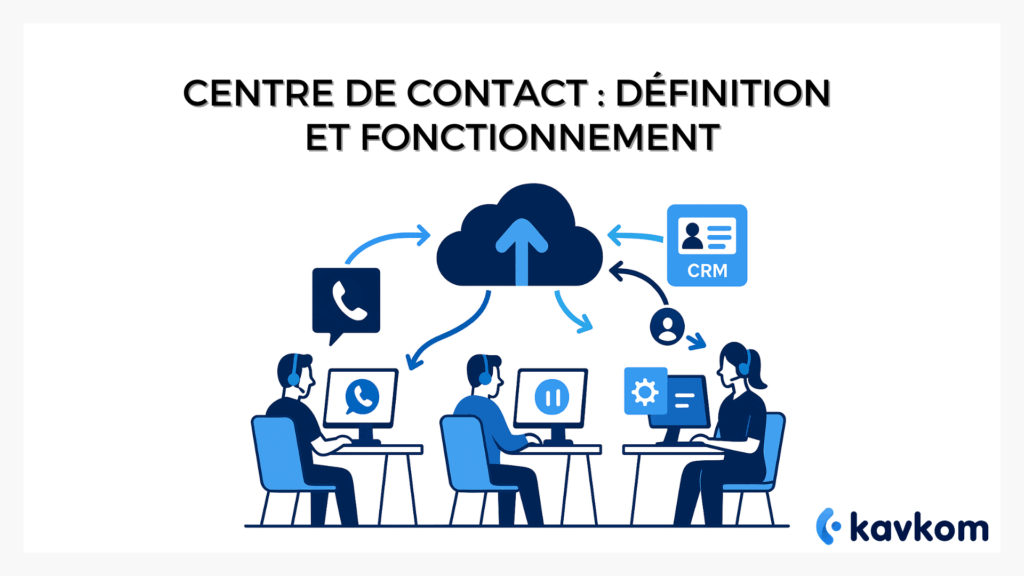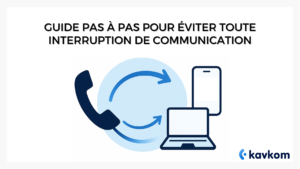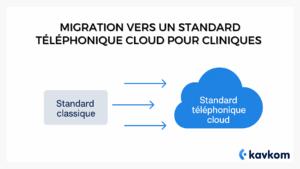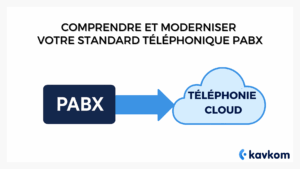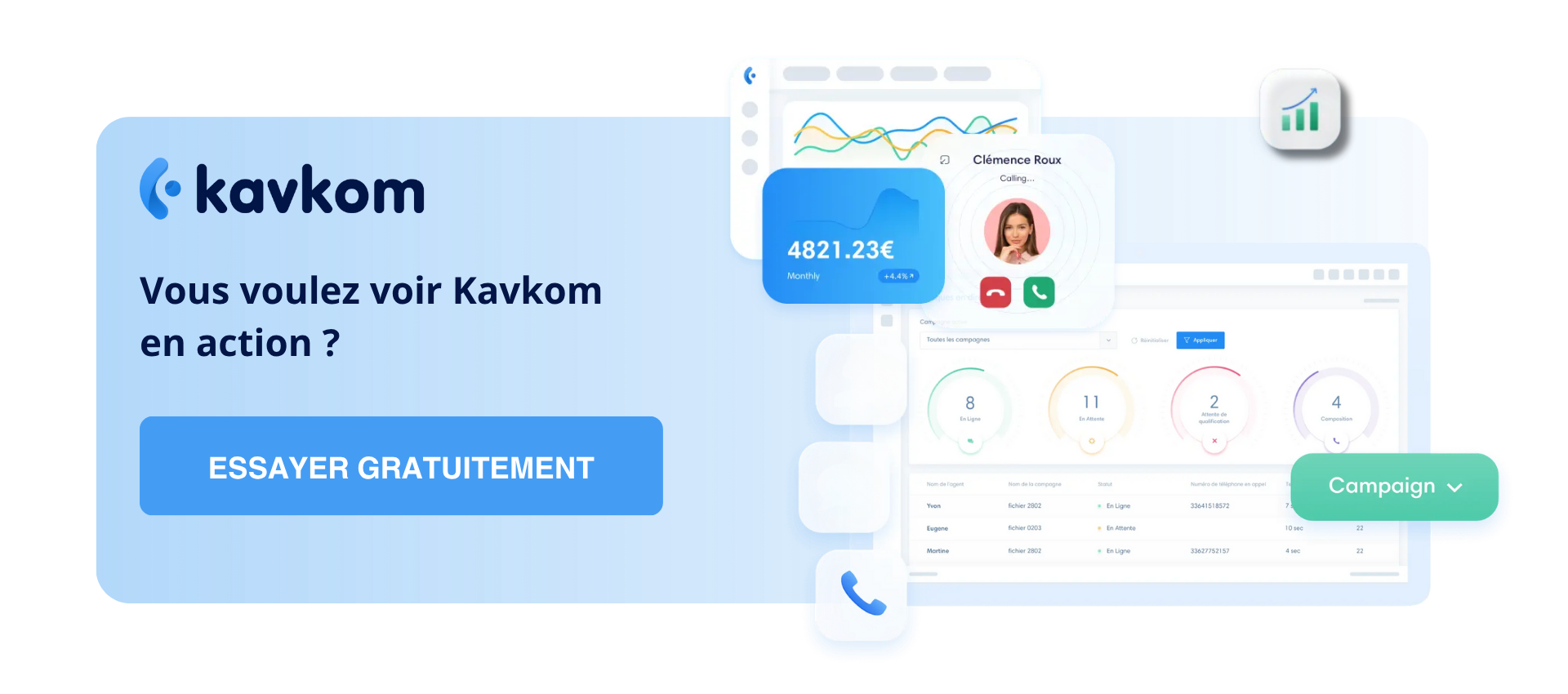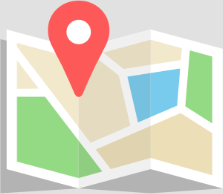In this article, discover how to understand and optimize a modern contact center. We take you step-by-step through how to simplify call management, improve interaction and integrate the cloud without commitment. You’ll know exactly how to transform your customer service for greater efficiency.
Points to remember
- A modern contact center can centralize voice and interface with third-party tools (CRM, helpdesk) for other channels.
- Moving to the cloud removes hardware constraints, reduces costs and facilitates scalability.
- Modern solutions like CCaaS offer better CRM integration, real-time tracking and a smoother customer experience.
- Migrating to a cloud contact center is a step-by-step process: assessing, selecting, configuring, training and monitoring.
- With a solution like Kavkom, you gain flexibility thanks to rapid installation, no commitment and pro rata billing.
What is a contact center and what are its benefits?
A contact center is much more than just a telephone switchboard. Unlike the traditional call center, which focused mainly on inbound and outbound calls, a contact center manages all interactions between a company and its customers: calls, e-mails, chats and even social networks. In other words, it becomes the beating heart of modern customer relations.
For a company, having a customer relations center that integrates all communication channels. is not just a luxury: it’s a strategic lever. Where teams once simply picked up the phone, today they orchestrate multiple channels in parallel to guarantee a better customer experience.
The big advantage? Centralizing all these flows. Modern contact centers offer a unified interface where each agent can find the complete history of exchanges. The result: faster responses, continuity of dialogue and a quality of service that is immediately felt by the customer.
In practice, a customer service supported by a cloud contact center helps to avoid silos and streamline customer paths. Each customer doesn’t have to repeat his or her story with every call: everything is already there, recorded and shared. It’s this ability to simplify and enrich the relationship that explains why companies are investing massively in these solutions.
How a contact center works
Arcep, in collaboration with Arcom, details in its Référentiel of digital uses in 2024 that the majority of French people already use several channels to communicate – smartphone, messaging, e-mail – a sign that our interactions have become plural and instantaneous. This trend illustrates exactly the profile of modern contact centers: platforms where calls, SMS, e-mails and instant messaging are orchestrated together, without chaos.
A contact center is above all a centralization of interactions. An agent can see, at a glance: yesterday’s call, today’s e-mail, this morning’s SMS. And there you have it: control over the customer journey without having to ask anyone to repeat themselves. The result? You avoid wasting time, you stay on track, and you offer a smoother, more precise, more… human response.
Managing this hub also means intelligently managing the voice channel: it remains the favorite when the problem becomes complex, but it’s no longer the only one. The other channels take over as needed, with live personalization, time-saving and instant response. All this, controlled from an intuitive interface, with the support of an integrated CRM. Just one screen, all the information, and the customer relationship moves forward smoothly.
Kit express – how a contact center works
- Calls, e-mail, SMS, messaging, all visible in the same space.
- All channels come together, without juggling.
- Structured interactions, one-click context, simplified customer journey.
- Well-informed agents = well-served customers (and everyone breathes easier).
Differences between a traditional contact center and a cloud solution
A traditional call center relies on a heavy infrastructure: technical cabinets, cabling, fixed licenses and lengthy contracts. These systems were efficient in their day, but today they limit flexibility and weigh heavily on the bill. Maintaining, upgrading and upgrading these call center systems is expensive, while at the same time hampering team agility.
Conversely, a contact in the cloud changes the game radically. A modern contact center solution is based on an online platform that brings together calling, recording, real-time supervision and CRM integration. There’s no need for proprietary hardware: everything is done via Internet access with compatible IP phones or softphones. In this way, contact center software or CcaaS software can be adapted to the size and needs of the company, without heavy investment.
This is where Kavkom perfectly illustrates the benefits of a contact cloud solution . The platform lets you manage all communications from your browser or cell phone, record and track conversations, while offering pro rata billing and, above all… no commitment. The result: flexible, scalable telephony that’s perfectly adapted to business fluctuations. And for your customers, this translates directly into improved continuity and quality of service.
Quick facts – Traditional vs. Cloud
- Traditional = dedicated equipment, fixed contracts, high fixed costs.
- Cloud = flexibility, scalability, flexible billing.
- With Kavkom = fast installation, no cables, no commitment.
Advantages of adopting a cloud solution for your contact center
ANSSI stresses that the cloud is both an opportunity and a challenge: this technology is accelerating digital transformation, while requiring particular vigilance with regard to data security and sovereignty. In short: the right cloud platform can be a powerful lever for modernizing a contact center.
With a contact center as a service (CCaaS), the company is no longer subject to the rigidity of hardware installations. A CCaaS solution enables you to provide an agile service: flexible, no-commitment invoicing, calculated in proportion to active lines, immediate ramp-up, adding or removing lines without waiting for a technician. The result is greater flexibility and lower costs.
On the operational side, a contact as a service brings together several channels – calls, SMS, e-mail, messaging – in a single interface. This centralization enriches the customer journey, reduces friction and raises service levels. The result: a better day-to-day customer experience.
Last but not least, the cloud increases visibility. Contact center solutions offer real-time performance monitoring: call statistics, perceived quality, agent productivity. These are all indicators that enable us tooffer a more responsive, more consistentservice, aligned with the expectations of each customer.
How do you set up a contact center cloud solution?
Step 1: Assess your needs and existing situation
Before diving in, take a moment to take stock. What are your customers’ recurring requests? Where are the irritants in your current service? Analyze your internal data set: call volumes, waiting times, pick-up rates. By identifying your strengths and weaknesses, you create a solid foundation. The challenge is simple: to understand how you can better support each customer by making more refined use of the customer data already available.
Practical benchmark: list 3 measurable objectives (e.g. reduce waiting times by 20%).
Step 2: Choosing the right cloud solution
The market is full of contact center solutions, but not all are created equal. Choose contact center software software that offers a clear, adaptable interface. The ability to customize reception, routing or statistics is a real plus. This is where Kavkom stands out: quick installation, simple customization, pro rata billing and no commitment. All with human support, not a chatbot on a loop.
Practical hint: test the demo before signing to judge ergonomics and learning time.
Step 3: Plan and prepare for migration
Migrating a center isn’t a matter of pressing a magic button. It’s about planning. Start by mapping your current center systems: which tools need to be connected, which lines removed? Think about balancing the workload of your teams during the transition. The aim is to keep the quality of your service intact, even during the changeover phase. A smooth migration is above all a realistic preparation.
Practical hint: plan a pilot phase with a small group of agents.
Step 4: Migrate to the cloud platform
Once the preparation is done, it’s time for action. Migration to a cloud contact is usually completed within a few days. Choose a contact solution that offers guided transfer tools and automatic updates. The result is a constant level of service, with no major interruptions. The goal: your customers won’t even notice the change, except through a smoother experience.
Practical tip: set up an in-house hotline on D-day to reassure your teams.
Step 5: Configure key functions (routing, registration, CRM integration)
This is where it all comes to life. Connect your CRMs and align the essential features: intelligent routing, double listening, call recording. Also make sure that theinterface groups channels (voice, SMS, e-mail, chat) and that you can manage all contact points from a single dashboard. Here, Kavkom makes it easy: configuration in a few clicks, ready-to-use CRM integrations, and human support to adjust to your needs.
Practical hint: first set up a small set of simple rules before going any further.
Step 6: Train and support your teams
A high-performance center relies on its center agents. Invest time in training, not only on the tools, but also on good customer
Practical tip: organize a “live coaching” session where each agent tests a real-life customer case.
Step 7: Supervise, monitor in real time and continuously optimize
Moving to the cloud is not an end, but a beginning. Use real-time monitoring tools to measure performance: waiting time, first call resolution rate, customer satisfaction. Evaluate the
Practical hint: set up a weekly dashboard shared with your teams.
Best practices for optimizing your cloud contact center
Set up a contact center cloud is the first step. Making it perform on a daily basis is another story. Here are a few simple levers to get the most out of your solution and deliver a better customer experience.
Optimization checklist
- Personalize customer paths: adapt greetings, scripts and queues to provide a more human service.
- Centralize all channels: calls, e-mails, SMS, chat. By handling all contact points in a single interface, you can reduce silos and streamline the customer journey.
- Continuous monitoring of your service quality: set simple indicators (pick-up rate, resolution time) and check them every week.
- Focus on regular training: well-coached agents are better able to deliver responsive, consistent service.
- Leverage data: analyze conversations and adjust processes. Data is your best mirror for adjusting the experience.
Absolutely avoid
- Forget real-time supervision.
- Underestimating the impact of software updates.
- Neglect internal communication: your teams need to share feedback and bottlenecks in order to progress together.
FAQ – Frequently asked questions
What is a contact center and how does it work?
A contact center is a platform that centralizes all customer interactions. It handles calls, e-mails, SMS messages and messaging. In concrete terms, here’s how this type of structure works: requests are routed to the appropriate agent, with a complete history available.
What’s the difference between a traditional call center and a cloud contact center?
A traditional call center relies on physical lines and hardware. In contrast, a cloud-based contact center relies on an online hosted solution. The cloud reduces costs and offers greater flexibility in resource management.
What advantages does a cloud solution offer in terms of flexibility and efficiency?
A CcaaS(contact center as a service) solution enables smoother customer relations: rapid ramp-up, adjusted billing and omnichannel management. It improves service levels and contributes to a better customer experience.
How can CRM integration improve contact center interaction management?
CRM integration links customer data to the history of exchanges. Agents can access all interactions from a single interface, with features that simplify follow-up and enhance service quality.
Conclusion
Modernizing a contact center with a cloud solution means reinventing customer relations. Where the traditional model reaches its limits, the cloud simplifies management, reduces costs and centralizes all channels.
Choosing a modern contact center solution also means focusing on the customer experience: a fluid path, better informed agents and consistent service. You’ll deliver a better customer experience , while keeping control of your resources.
Now it’s up to you to discover the tangible benefits of a cloud contact center and take the next step towards a simpler, more efficient relationship.
